|
|
|
Sort Order |
|
|
|
Items / Page
|
|
|
|
|
|
|
| Srl | Item |
| 1 |
ID:
137174
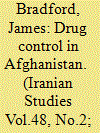

|
|
|
|
|
| Summary/Abstract |
This article explores the process leading to the Afghan government's decision to implement a prohibition and eradication of opium in the northeastern province of Badakhshan. It explores why Daud chose Badakhshan, the impact of the opium ban on the people of Badakhshan and the future of opium production and trade, as well as the evolution of drug control in Afghanistan under the Musahiban dynasty. Ultimately, the ban was launched because it allowed Daud to garner international praise and financial support, while enforcing eradication in an area inhabited by ethnic minorities ensured that the Afghan government's coercive strategy would not generate resistance from rural Pashtun tribes historically opposed to these types of state intervention.
|
|
|
|
|
|
|
|
|
|
|
|
|
|
|
|
| 2 |
ID:
137171
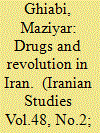

|
|
|
|
|
| Summary/Abstract |
On 27 June 1979, Ayatollah Khomeini declared, ‘drugs are prohibited” and their trafficking, consumption and “promotion” were against the rules of Islam and could not take place in the Islamic Republic. This ruling, although informal in nature, sanctioned a swift re-direction of Iran's previous approach to narcotic drugs, both in terms of production and consumption. As had happened in 1955, Iran seemed ready to go back to a policy of total prohibition and eradication of opiates, this time under the banner of Islam rather than that of the international drug control regime. Drugs and the politics surrounding them have been a crucial, yet neglected, aspect of the history of modern Iran that have changed the nature of the state bolstering its capacity of social intervention, while hindering its legitimacy, in the Pahlavi, as in the republican, era. By moving on “from the analysis of the state to a concern with the actualities of social subordination”, this article attempts to interpret how social subordination and state coercion were practiced and defied in the making of punishment and welfare in the social body of Iran.
|
|
|
|
|
|
|
|
|
|
|
|
|
|
|
|
| 3 |
ID:
137172
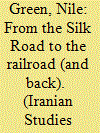

|
|
|
|
|
| Summary/Abstract |
In view of the recent expansion of Indo-Persian studies, the neglect of the Sino-Persian nexus is a missed opportunity to place Iranian history on a larger Asian stage. While Iranian contact with China has continued episodically from antiquity to modernity, scholars have so far focused almost exclusively on the pre-modern phases of exchange. As a contribution to developing the field of Sino-Persian studies, this article situates two twentieth century Iranian travelers to China against the changing background of Chinese–Iranian exchange from the medieval to modern period. In so doing, it demonstrates the infrastructural and conceptual apparatus that enabled the modern Iranian encounter with China while asking how, if at all, twentieth century intellectuals were able to draw on a longer history of interaction to find meanings for Sino-Persian exchange.
|
|
|
|
|
|
|
|
|
|
|
|
|
|
|
|
| 4 |
ID:
137173
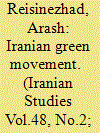

|
|
|
|
|
| Summary/Abstract |
The Iranian Green Movement emerged after the presidential election in June 2009. The paper tracks down its foundational origins through the concept of ‘fragmented collective action’, that points to the dispersion of a social movement's political energies and the fragmentation of its constitutive groups. It also addresses the significance of informal mobilizing networks and the widespread use of modern virtual space to bring together an intersubjectively constructed collective identity which was shaped by the movement’s interactions with political forces and with its interlocutors. Finally, the paper argues that the collective identity shaped the movement's strategies over the course of its evolution.
|
|
|
|
|
|
|
|
|
|
|
|
|
|
|
|
| 5 |
ID:
137176
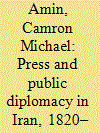

|
|
|
|
|
| Summary/Abstract |
The under-appreciated role of the press as a tool of public diplomacy was rooted in its origins as a Qajar state project in the nineteenth century, but also cultivated by a shared impulse of Iranian journalists and statesmen to represent Iran effectively in the court of world opinion. Moreover, foreign governments often reacted to the Iranian press generally, not just the official newspapers and not just newspapers produced in Iran, as a forum though which to advance or protect their interests in Iran. The Pahlavi state integrated the press as part of a larger state-run mass communication policy in the 1930s that would eventually include new technologies such as radio, and retained public diplomacy as an essential purpose of the media. This study draws upon archival material, press accounts, and memoirs.
|
|
|
|
|
|
|
|
|
|
|
|
|
|
|
|
| 6 |
ID:
137175
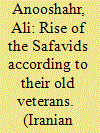

|
|
|
|
|
| Summary/Abstract |
This article studies an early Safavid chronicle, Futuhat-e Shahi by Amini Haravi. In 1521, the founder of the Safavid state, Shah Isma‘il, provided Haravi with a number of veterans from the early days of the Safavid uprising as informants. Their narrative presents an alternative view on the early career of the shah that differs from the dominant version current in modern scholarship. From the perspective of the Futuhat, the rise of the Safavids did not occur as a wild apocalyptic explosion, but was a carefully planned and cautious campaign run by experienced commanders who kept a tight rein on the teenage Shah Isma‘il.
|
|
|
|
|
|
|
|
|
|
|
|
|
|
|
|
|
|
|
|
|